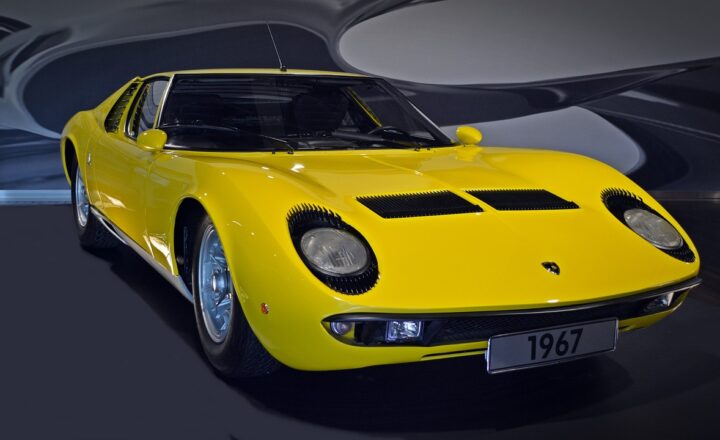The Ferrari F40: A Supercar That Redefined Speed and Performance Forever
November 18, 2024

The Ferrari F40 is not just a car; it is an icon, a symbol of automotive excellence that stands tall in the annals of sports car history. Introduced in 1987, the F40 was the last car approved by Enzo Ferrari himself before his passing, and it was designed to embody the passion, ingenuity, and racing spirit of the brand. This masterpiece not only redefined performance but also set new benchmarks in the world of supercars, making it a worthwhile subject of discussions among enthusiasts and collectors alike.
1. The Birth of the F40: Vision and Innovation
The story of the Ferrari F40 begins with Enzo Ferrari’s vision for a car that could celebrate the company’s 40th anniversary. It became the last car bearing Enzo’s direct influence, emphasizing pure performance without unnecessary luxury. The goal was clear: to create the fastest production car in the world.
To achieve this mission, Ferrari employed cutting-edge technology and innovative methods. One of the main features of the F40 is its use of lightweight materials; the chassis is made from a tubular steel structure and the body panels from composite materials, including Kevlar and carbon fiber. This results in a stunningly low weight of just 1,100 kg (2,425 lbs).
The heart of the F40 is its extraordinary 2.9-liter twin-turbo V8 engine, producing an astonishing 478 horsepower at 7,000 RPM. With a 0 to 60 mph time under 4 seconds and a top speed that exceeds 200 mph, the F40 was a formidable rival not only to its contemporaries but also to the future supercars that would follow.
2. Design: A Blend of Functionality and Aesthetics
The F40’s design is a masterpiece, a perfect blend of functionality and aggressive aesthetics. The aerodynamics of the car play a crucial role in its performance. The iconic rear wing, designed for maximum downforce, not only adds to its menacing persona but also enhances stability at high speeds.
The design elements of the F40 are unmistakable. Its unmistakable profile, with sharp lines that exude aggression, is complemented by flared wheel arches. The low-slung body and the characteristically Ferrari headlights give it an unmistakable presence on the road and track.
Moreover, the rear engine configuration is visible through the transparent engine cover, allowing enthusiasts to admire the engineering brilliance that powers this beast. The minimalist interior is devoid of excesses, focusing on the driver experience, with an emphasis on racing. Lightweight racing seats, a simple dashboard, and a lack of extravagant materials are all choices that underline the F40’s true purpose – absolute driving performance.
3. A Testament to Performance: Driving the F40
Driving the Ferrari F40 is an experience that goes beyond mere transportation. It’s an event. The car’s twin-turbo V8 provides instantaneous power, and the roar of the engine is enough to send shivers down the spine of any car enthusiast.
Unlike modern supercars, the F40 connects you directly with the road. The steering is incredibly responsive, giving the driver exceptional feedback. Precise handling comes thanks to the balanced weight distribution and superb chassis. On the track, the F40 behaves predictably, allowing for thrilling cornering and acceleration bursts.
The thrill of pushing the F40 to its limits is an unmatched experience. With power and speed comes responsibility, and the F40 requires a skilled driver. Its raw nature is a reminder that driving isn’t just about the destination, but the journey – every twist, every turn becomes a cherished memory.
4. Racing Heritage: The F40 in Competition
The allure of the Ferrari F40 is not limited to its prowess on public roads; it has also made a name for itself in racing circles. Although it was not primarily designed as a race car, the F40’s pedigree caught the attention of several racing enthusiasts and professionals.
In the late 1980s and early 1990s, several F40s participated in various GT racing championships. The most notable victory occurred in 1989 at the 24 Hours of Le Mans, where a privateer F40 secured a commendable finish, showcasing the car’s incredible durability and engineering.
In addition, racing preparation of the F40 led to the development of the F40 Competizione, a version specifically designed for racing with further modifications like lightweight panels, a more powerful engine, and race-specific suspension setups, underlining Ferrari’s commitment to blending performance with competition.
5. Collectibility and Legacy
As the years rolled on, the Ferrari F40 earned a place in the hearts of collectors and car enthusiasts. Its production ended in 1992, with only 1,311 units produced, making it a rare gem in the automotive world. The F40’s value has significantly increased, with pristine models fetching prices well beyond $1 million, cementing its status as a collectible.
The legacy of the F40 is substantial. It set the stage for future Ferrari models, influencing the design and performance expectations of sports cars to follow. The principles of lightweight construction, turbocharging technology, and focus on driver experience established by the F40 paved the way for newer, more advanced supercars.
Today, the Ferrari F40 is regarded as one of the greatest supercars of all time, often included in discussions about legendary vehicles alongside icons such as the McLaren F1 and Porsche 911 GT1. Its hold on the automotive enthusiast community remains impressive, often featured in car shows and museum exhibits across the globe.
Conclusion: The Enduring Spirit of the F40
The Ferrari F40 is more than just an automobile; it is a testament to what can be achieved when passion, engineering, and art converge. Through its cutting-edge technology and phenomenal performance, it redefined the concept of a supercar, leaving an indelible mark on the automotive industry. As we continue to celebrate its legacy three decades later, the F40 endures as a symbol of speed and performance, inspiring generations of car lovers and engineers alike. Its story is one of uncompromising ambition and passion, ensuring its place in the hearts of enthusiasts forever.








